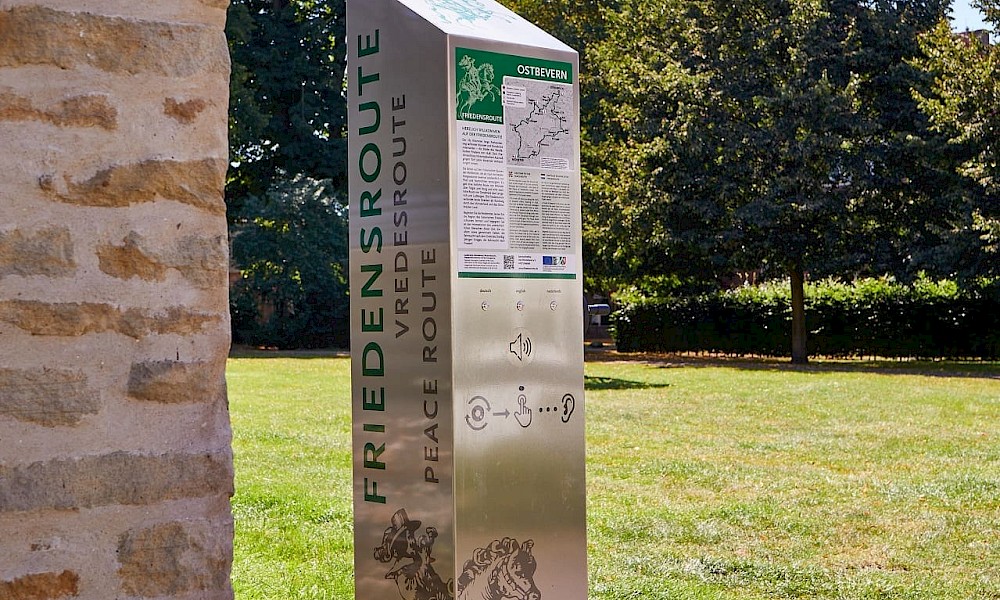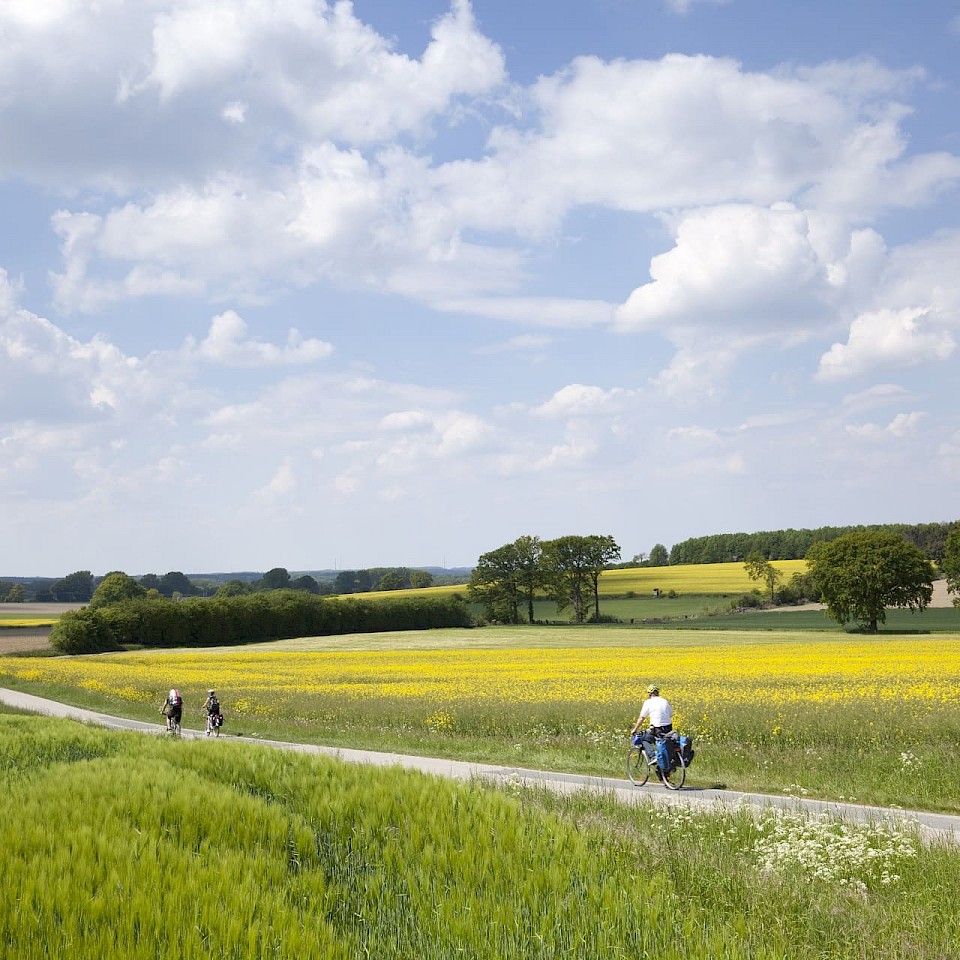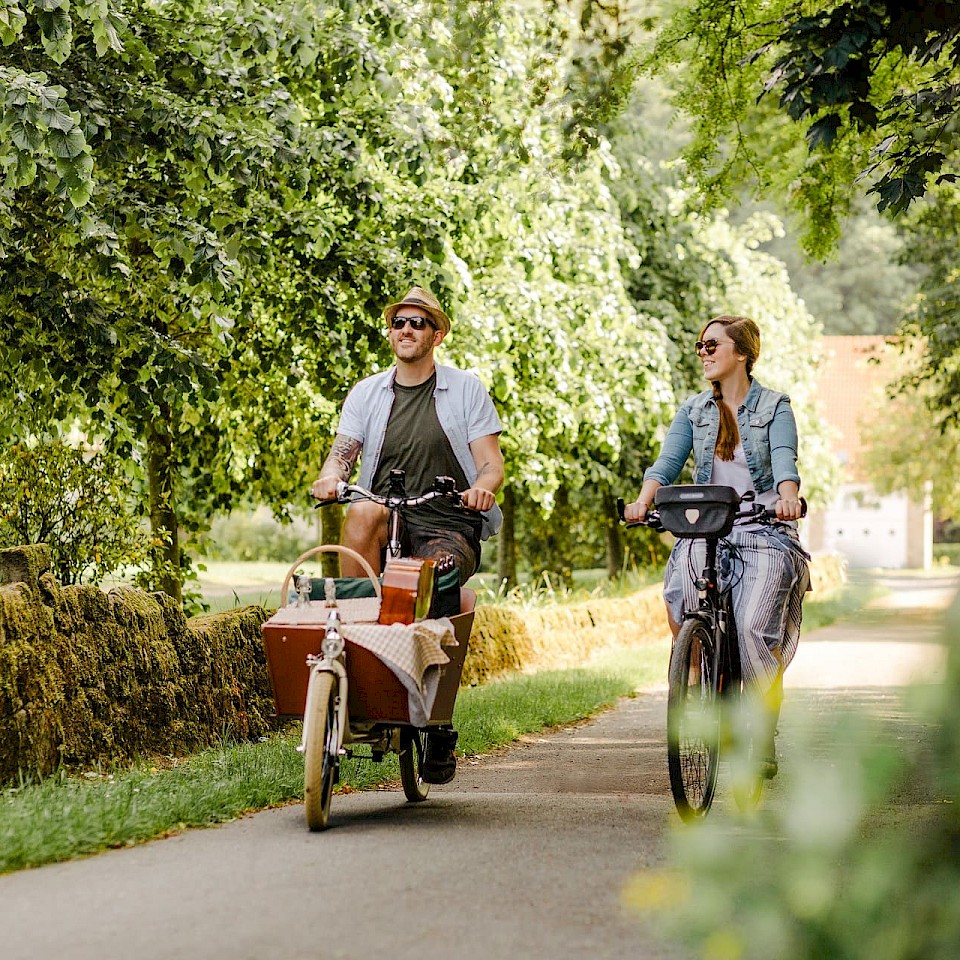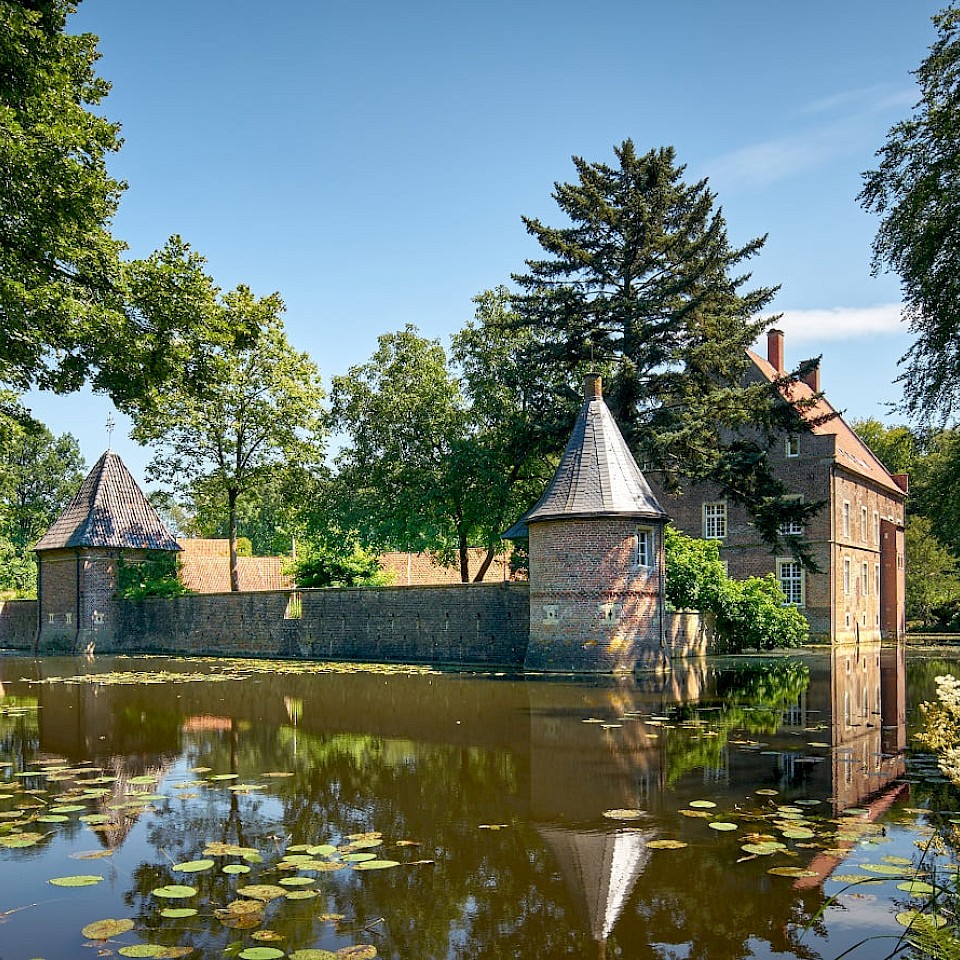
© Münsterland e.V. / Christoph Steinweg
Peace Route
On the Peace Route you travel through world history. For five years, the cities of Münster and Osnabrück fought for peace and the end of the Thirty Years' War in Germany. News and updates between the two places of negotiation were exchanged by the peace riders. Follow the historical paths of the mounted messengers on a cycle tour along the Peace Route. Places steeped in history, hidden secrets and wonderful landscapes await you.
By the way: If you don't want to plan your own cycling tour on the Peace Route, you can opt for a multi-day package tour.
The prelude in the city of peace Münster
The City of Peace Münster is the starting point for both routes of the Peace Route. Münster's historic town hall with its famous Peace Hall is located directly on Prinzipalmarkt. The cityscape of Münster shows its most beautiful side here. The life of the city pulsates under the picturesque arcades and on the square. Only a few metres away, the cathedral, the Erbdrostenhof, the St. Lamberti Church and countless other sights and cultural institutions entice you to visit the city. It is immediately noticeable: Here, modernity and tradition go hand in hand.
On the West Course of the Peace Route
From the Ems to the balcony of Münsterland
Shortly after Münster, the Münsterland park landscape takes over. The nature reserve of the Rieselfelder and the picturesque village of Gimbte are on the way to Greven. The Ems meadows and the Ems are your companions all the way to the Emsstadt. The reconstruction of a 1200-year-old Saxon farm takes you back to the Middle Ages. Via the historic "Alte Post" (old post office) in Ladbergen, the cycle path leads to the foothills of the Teutoburg Forest. The hilly landscape is a paradise for cyclists. Beautiful panoramic views compensate for the odd climb.
At Haus Marck, one of the sites of the preliminary negotiations, you should definitely make a detour to the magnificent old town of Tecklenburg . The market square lined with half-timbered houses will enchant you. At the foot of the Teutoburg Forest, the Peace Route heads towards Lengerich. At today's town hall square, another chapter of world history was written that continues to have an impact today. A few kilometres further on is the picturesque little town of Leeden. The route takes you past numerous testimonies to industrial culture and through the Terra.vita nature park to Hasbergen.
A few metres further on you have reached Osnabrück . The centre of the city is the beautiful market square with the historic town hall, which houses the Peace Hall. Explore the city on a guided tour, stroll through the shopping streets and enjoy the wide range of gastronomic delights.
On the eastern course of the peace route
Those who cycle the Peace Route as a circular route cycle from Osnabrück in the direction of Hagen am Teutoburger Wald. For a real experience, it is worth making a detour to the Silberseestollen with a guided tour through the underground vault.
In the Kneipp spa town of Bad Iburg, the castle with its knights' hall is particularly worth seeing. The Peace Route then leads via the spa town of Bad Laer into the flat Münsterland park landscape. In Ostbevern, the beautiful park of Loburg Castle is a surprise. The quiet paths lead through a wildly romantic landscape of rhododendrons, trees and small ponds.
Telgte - a place steeped in history with an enchanting old town
"Romantic" is also the right description for the small town of Telgte. Small alleys wind through the pretty town, widening into cosy squares, only to open up new vistas around the next bend. On a tour, look out for the many sculptures scattered around the town. The jewel of the town is the pilgrimage chapel with the image of the "Sorrowful Mother". In 1654, Münster's Prince-Bishop Christoph Bernhard von Galen personally laid the foundation stone of the baroque octagonal building.
Telgte received its connection between the Thirty Years' War and literature through the book "Das Treffen von Telgte" by Günter Grass. In the fictional meeting, numerous German poets discuss the Peace of Westphalia and the state of the German language.
A special recommendation is a visit to the Westphalian Museum of Religious Culture "RELíGIO". In addition to many interesting exhibits, the Telgte Hunger Cloth is of particular importance.
Stations of history on the Peace Route

© Münsterland e.V./Philipp Fölting
At the end of the Thirty Years' War, Münster was at the centre of world history. Five years were spent in complicated negotiations to achieve peace. The proclamation of the Peace of Westphalia in 1648 has had a decisive influence on life in Münster as a city of peace to this day. The Peace Hall in the historic town hall impressively tells the story of this time.

© Münsterland e.V./Philipp Fölting
The small town of Ladbergen was the stage for the very big European politics. Halfway between Münster and Osnabrück, the two parties met here for preliminary negotiations of the Peace of Westphalia. Particularly difficult issues could be discussed discreetly here. The Gasthaus zur Post became the hub of the negotiations and soon also an important postal station. Stables for twelve horses and four rooms were available for travellers.

© Münsterland e.V./Philipp Fölting
The House of Marck in Tecklenburg played an important role in the negotiations to end the Thirty Years' War. As early as 1643, important preliminary negotiations between the various powers took place here between the peace cities of Osnabrück and Münster. Today, Haus Marck can be visited on guided tours. High-class castle concerts are held regularly.

© Sabine Braungart
The "Lengerich Conclusum", which marked the first time in the German Empire that all imperial estates had a say in domestic and foreign policy issues, was the result of preliminary negotiations in Lengerich in 1645. Eberhard Koch's house, which was used at the time, stood on what is now Rathausplatz. The ideas of the "Lengerich Conclusum" are still effective today and were a cornerstone for the union of the United Nations.

© Münsterland e.V./Philipp Fölting
It is probably unique for a castle to be home to a Catholic and a Protestant church. The eventful history as the seat of the Prince-Bishops of Osnabrück made it possible. The castle was badly damaged during the Thirty Years' War. In 1714, Prussia's first queen was born here. The Knights' Hall is particularly worth seeing.

© Janna Kamphof
World history was made in Osnabrück's town hall without any exaggeration. The German Emperor and the Queen of Sweden negotiated parts of the Peace of Westphalia here, which was proclaimed on 24 October 1648. The participation of numerous smaller states was new - a pan-European peace conference. The city's Peace Hall bears impressive witness to the five years of negotiations.

© Münsterland e.V./Philipp Fölting
The octagonal chapel is the first building built as a direct result of the Peace of Westphalia. The image of the "Sorrowful Mother", carved from poplar wood in around 1370, established Telgte's position as a supra-regional place of pilgrimage. In 1654, Prince-Bishop von Galen personally laid the foundation stone for the construction of the chapel in the war-ravaged region.
The Peace Route at a glance
- 163 km
- Circuit
- medium
- signposted
- Multiday tour
- History/Nature
- Münster
- Greven
- Ladbergen
- Tecklenburg
- Lengerich
- Lienen
- Bad Iburg
- Hagen a.T.W.
- Hasbergen
- Osnabrück
- Bad Laer
- Glandorf
- Ostbevern
- Telgte
Downloads
Insider tip
If the entire route is too long for you to cycle, simply use the excellent rail connection between Osnabrück and Münster. Intercity and regional trains take about 30 minutes to cover the distance between the two cities of peace. Even the peace riders would be amazed.






























Spread the word! #münsterland #thegoodlife